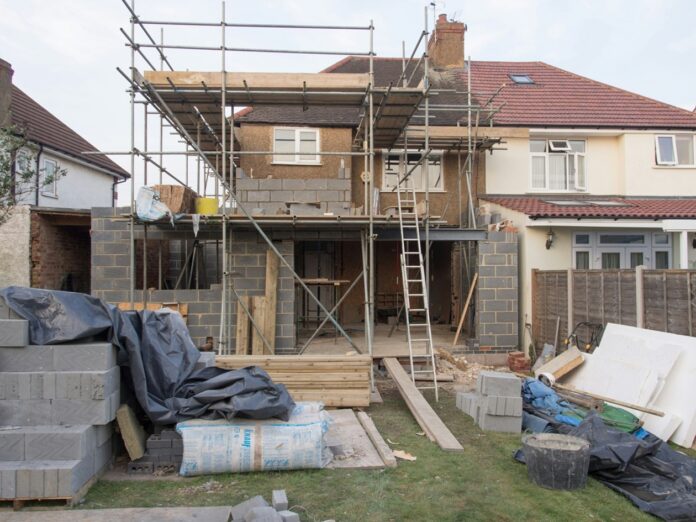Craving extra square footage without all the moving house stress?
House extensions are one of the best investments homeowners can make. Forget the hassle of estate agents, stamp duty, and packing up your life — just add the space you need where you’re already living.
Problem
Most people assume that building an extension will cost a small fortune. And of course, if done wrong it will empty your bank account. But when approached correctly, adding some space to your home is surprisingly affordable, and can add serious value to a property.
Here’s The Deal:
- Why house extensions make financial sense
- The most affordable types of extension
- Smart ways to slash extension costs
- How to get maximum value from every pound spent
Why house extensions make financial sense
Extending a property is often cheaper than moving house. Simple. No estate agent fees, stamp duty, and solicitor’s costs nibbling away at the budget.
But here’s the clincher…
Research shows that house extensions can add significant value. Adding a double bedroom increases value by 12%, while a double bedroom with en-suite bumps up value by 23% on average.
That’s a pretty solid return on investment.
The average house extension costs around £40,000 in the UK. Compare that to the cost of moving – which can easily hit £10,000-£15,000 all in – and staying put becomes very attractive.
The most affordable extension types
Not all house extensions cost the same.
Some are much cheaper than others, as we’ll see below. The type and size of an extension are the biggest factors in price, but it’s also possible to influence costs from the project design stage.
Here’s what needs to be known:
Single-Storey Rear Extensions
The most popular choice of extension for a reason.
Single-storey rear extensions are easy to build and offer the best bang for buck in terms of value.
Typically, prices hover between £1,800 and £3,000 per square metre. So, for a decent 20m² extension, you’re looking at between £36,000 and £60,000 total.
That translates to extra kitchen space, more room in your living area, or that dining room you’ve always dreamed about.
Side Return Extensions
Got a narrow side passageway? That’s prime real estate ripe for using.
Side return extensions are ideal for terraced and semi-detached houses. They’re usually more compact than rear extensions but still add useful square footage to the home.
Costs for most side returns come in below £35,000 because of their smaller size.
Lean-To Extensions
Want the cheapest option possible?
Lean-to extensions (aka conservatory-style extensions) start from as low as £1,800 per square metre.
Simple structures like this can be built very quickly and require less groundwork than traditional extensions. Perfect for making a sunroom, home office or extra living space on a tight budget.
Smart ways to slash extension costs
Ready to cut some serious costs? Here are the strategies that work…
Take Advantage of Permitted Development Rights
This is a big one.
Under permitted development rights, homeowners can build:
- Single-storey rear extensions up to 6m (semi-detached/terraced) or 8m (detached)
- Side extensions up to 4m high
- Two-storey extensions up to 3m
No planning permission required.
A massive saving in both time and money. Planning applications cost on average £500-£1,000 and can take months to process.
Choose Simple Designs
Complex designs = complex price tags.
Stick to basic rectangular shapes, and avoid crazy angles, multiple roof lines, and wacky structural elements. A simple box extension will cost significantly less than an elaborate design, even if the floor space is identical.
Be Strategic With Materials
Premium materials look amazing but will smash any budget quickly.
Opt for standard bricks, basic roof tiles, and simple glazing instead. They get the job done at a fraction of the cost. Leave the high-end finishes to the areas where people will actually notice them.
Wanna bifold doors? Consider standard patio doors instead and save £2,000-£4,000 in one go.
Do some of the work
You don’t need to DIY the whole project, of course. But certain tasks can be handled in-house to drop costs dramatically.
Consider taking on:
- Painting and decorating
- Landscaping the garden after work is completed
- Fixtures and fittings installation
- Basic finishing touches
Decorating alone can shave £2,000-£3,000 off the total bill.
Get multiple quotes
Seems obvious but people keep missing this step.
Get at least three detailed quotes from separate builders. Prices can swing by 50% or more for identical work. That’s thousands of pounds just sitting on the table.
Just make sure each quote is for the exact same scope of work to ensure like-for-like comparisons.
Getting maximum value from every pound spent
House extensions aren’t just about adding space.
It’s about adding the right type of space. Certain additions and layout features will return more value when it comes to selling the property.
Here’s what adds the most value:
Focus on kitchens and bathrooms
Kitchen extensions consistently return the best value.
Families spend most time in kitchens, and buyers pay premium prices for open plan kitchen-diners. Adding a bathroom gives a solid 6% boost to property value. En-suite bumps this to 23% if space allows.
Create open-plan living
Knocking through walls to create one large open space is more valuable than many small rooms. Buyers these days want light, airy, open plan living spaces.
This might involve incorporating the old kitchen area into the new extension, creating one giant kitchen-diner-living space.
Maximise natural light
Dark, dingy extensions add less value.
Big windows, roof lights, skylights. Whatever. Fill it with light. Light makes space feel bigger and more inviting. And this doesn’t have to cost a fortune either – standard roof windows start from £500 installed.
Don’t skimp on insulation
Good insulation costs a little more upfront but saves money on energy bills for decades to come.
Modern building regs require good insulation anyway so might as well go slightly above minimum standards. Future buyers will thank you for it.
Plan for future flexibility
Design the extension to work in more than one way.
Ground floor extension with plumbing connections could be a bedroom, office, granny flat, playroom or home gym.
This flexibility makes the property more attractive to a wider pool of buyers.
Hidden costs to budget for
Extensions almost always cost more than the initial quote.
Plan for it from the beginning. Set aside an extra 10-20% of the budget as contingency. Extensions take 10-18 weeks on average to complete, and things crop up all the time.
Common extras that get missed in the initial quote:
- Moving drainage pipes or services
- Upgrading the heating system to cover the new space
- New flooring throughout to match the extension
- Redecorating adjoining rooms after work is completed
- Temporary kitchen facilities during building work
Smart homeowners budget for all this from day one rather than getting caught out halfway through the project.
Pulling the trigger
House extensions are one of the best ways to add space and value to property. With the right approach, creating that extra room doesn’t have to cost a fortune.
Remember:
- Simple designs cost less than complex ones
- Use permitted development rights to avoid planning fees
- Get multiple quotes and compare carefully
- Focus on kitchens and open-plan living for maximum value
- Budget 10-20% extra for the unexpected
Start by working out exactly what space is needed and what budget is realistic. Then get quotes from local builders and see what’s possible.
The space needed might be more affordable than you thought.






